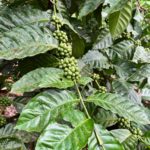Coffea Arabica vs. Coffea Canephora Not Just Another Flavor — A Different Species
A visit to a coffee bar, whether a link in a large chain (the usual suspects) or a local one espresso machine cafe, generally reveals coffee from a variety of sources – some familiar, some not. If you care about the contents of your cup, read on.
Most “specialty,” a.k.a. expensive, coffee is the fruit of the tree, coffea arabica, generally called Arabica. Even mass-market sludge such as Nescafe touts that its Nescafé Clásico Colombian instant is 100% Arabica. Some of its other blends, such as Brazil, simply label themselves as 100% coffee, without further specification. If, as is likely, they use Robusta, they don’t specify it. Among some coffee aficionados and not a few coffee snobs. Robusta is Arabica’s poorer step-sister.
A behemoth like Starbucks dismissed the entire category. “It comes down to flavor. And that less refined flavor is absolutely the reason we don’t even touch it (Robusta).”
Even mid-market players like McDonald’s and Dunkin’ Donuts promote their coffees as “100% Arabica.”
Robusta’s inferior status can be a self-fulfilling prophecy — cheaper coffee handled cheaply and marketed to less demanding or price sensitive customers.
According to some coffee experts, this may be changing. I recently encountered a potential herald of this change while on assignment in the Ecuadorian Amazon.
Case in point, Witoca, , a cooperative of coffee and cocoa growers is making the case for high end Robusta. Why do they bother? Their founders believe that properly bred, grown, and processed, Robusta has unique advantages for both its producers and customers.
Coffee as a crop faces a number of challenges and these are made worse by a warming climate. Coffee leaf rust — a fungal disease, which stunts and shrivels the leaves is increasing. Robusta is

Coffee Leaf Rust
relative resistant to this blight. Arabica needs higher altitude and shade to prosper. Robusta can do well at warmer lower altitude with less shade.
Witoca farmers grow both Robusta and Arabica. A trek through a coffee plantation reveals sickly Arabica trees but vigorous Robusta. Robusta is living up to its name and being a hardier species. It is better adapted to Ecuador’s weather and ecosystem and yields substantially more per unit of land cultivated.
But standard Robusta lacks both the reputation to command the higher price to improve the

A Productive Plant
lives of the growers. Rather than falling into a commodity mindset and just maximize yield, Witoca has been selectively breeding Robusta to enhance its smoothness and aroma, while maintaining its hardiness.
Robusta is generally thought to have a more earthy and bitter taste than Ababica. Witoca believes that its selective breeding program has and can continue to improve its taste. Robusta is naturally higher in antioxidants and nearly twice as high in caffeine as Arabica. For some

A Happy Robusta Tree
niche brands based on Robusta, such as Death Wish and Biohazard, the caffeine kick is touted front and center. Interestingly, high caffeine concentration may be one factor in its disease resistance. Whether it’s a benefit to the drinker depends on personal preference. In my travels, “Decafe” as a category barely exists in Central or South America.
Witoca also operates a comfortable rustic café on a back road, serving its coffee in a full range of coffee drinks from espresso to cappuccino, all made from Robusta. I particularly liked their Americano.
What is apparent is visiting a farm of one of Witoca’s member growers, is the pride they take in the care and production of their crop.
As with other beverages, consumers know what they like rather more than why. Robusta itself is not a top of mind category nor is it differentiator. Its Amazonian heritage may just be…
